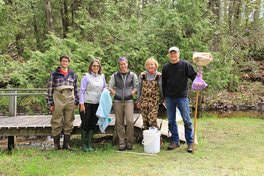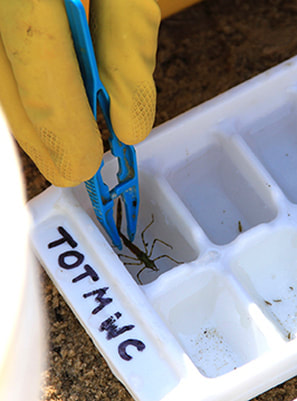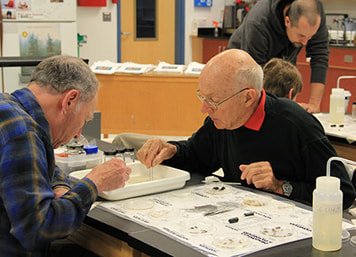Volunteer Stream Monitoring Program

History
Many lakes in Northern Michigan have been monitored by volunteers for over 30 years. Dedicated volunteers venture out onto the lakes every week during the summer months to collect invaluable water quality data that is used by many organizations and residents in efforts to preserve and improve the health of our lakes. Obviously, volunteers are working hard to monitor lake water quality, but what about streams? Do streams potentially impact the water quality of the lakes that they flow into? Should they be monitored? We at the Watershed Council think so and have thus, embarked upon a new voyage up into the streams that feed into our pristine lakes, with volunteer crews willing and ready to monitor in unfamiliar, yet ecologically critical waters. |
Volunteer Stream Monitoring Database
Click the button below to download our Volunteer Stream Monitoring Data gathered by volunteers on streams and rivers throughout our service area. |
In early 2005, Tip of the Mitt Watershed Council applied for and was awarded a two-year grant by the Michigan Clean Water Corps to kick-start the new Volunteer Stream Monitoring Program. For several months after receiving the grant award Watershed Council staff busied themselves with structuring the program, developing a Quality Assurance Protection Plan, purchasing necessary equipment, and recruiting volunteers; all in preparation for monitoring activities. By September, 2005 everything was in place and volunteers began their maiden voyage into stream ecosystems by first receiving a training provided by Watershed Council Staff at the Freshwater Center in Petoskey and then, going into the field to collect data.
In August 2011, Tip of the Mitt Watershed Council was awarded an additional grant from the Michigan Clean Water Corp to expand the Volunteer Stream Monitoring Program to include eight new sites on two beautiful blue-ribbon trout streams - the Maple River and the Sturgeon River. The addition of these two rivers raises the total number of site monitored to 37 sites.
Other sites currently being monitored include steams flowing into Black Lake, Mullett Lake, Lake Charlevoix, Torch Lake and Little Traverse Bay. These still represent only a small fraction of the streams found in the Watershed Council service area, but include streams that have potential water quality issues or areas of concern as expressed by local residents. As the program's foundation strengthens, it will be expanded to include more of the 2500+ miles of streams that crisscross the tip of the mitt.
In August 2011, Tip of the Mitt Watershed Council was awarded an additional grant from the Michigan Clean Water Corp to expand the Volunteer Stream Monitoring Program to include eight new sites on two beautiful blue-ribbon trout streams - the Maple River and the Sturgeon River. The addition of these two rivers raises the total number of site monitored to 37 sites.
Other sites currently being monitored include steams flowing into Black Lake, Mullett Lake, Lake Charlevoix, Torch Lake and Little Traverse Bay. These still represent only a small fraction of the streams found in the Watershed Council service area, but include streams that have potential water quality issues or areas of concern as expressed by local residents. As the program's foundation strengthens, it will be expanded to include more of the 2500+ miles of streams that crisscross the tip of the mitt.
|
Volunteer Stream Monitoring training takes place twice a year, during the spring (May) and fall (September).
For more information about our free trainings, contact (231) 347-1181. |
Program
Volunteer teams monitor the water quality of wadeable streams two times a year, during the spring (May) and fall (September). Teams consist of 3 or more volunteers, including a team leader, team collector and at least one picker. Prior to the outdoor field data collection volunteers receive specialized training. Following the field activities, volunteers and experts gather for an indoor identification session. Trainings are held twice a year at the Freshwater Center for team leaders and collectors. Indoor training presentations provide volunteers with information about program structure and goals, methodologies, field equipment, filling out data forms and biology of macroinvertebrates (e.g. aquatic insects, crustaceans, and other small aquatic "critters"). In addition, volunteers accompany Watershed Council staff to a nearby stream for an outdoor practicum to go over field methods and techniques. Leaders are trained to coordinate team activities in the field, collect pertinent information recorded on survey forms, and ensure quality control in data collection. Collectors are trained to thoroughly sample all habitat types found in stream ecosystems. |
|
Watershed Council staff assign volunteers to teams and teams are given two sample sites to collect data from. On field days, volunteers meet at a predetermined sample site to begin their work. Typically, volunteers spend 2-3 hours at each site collecting information. While leaders note relevant information on the survey form, collectors use a net to vigorously sample all habitats in the stream reach, emptying the net's contents on trays so that pickers can pick and preserve specimens in alcohol for later identification.
Identification of aquatic macroinvertebrates takes place a few weeks after field day. Volunteers congregate at the Watershed Council office with macroinvertebrate samples in hand. The "critters" collected in the field are sorted by volunteers using trays and identification keys, largely based upon physical appearance, though utilizing volunteer taxanomic knowledge when able. Then, local experts trained in macroinvertebrate identification, sit down with volunteers to verify identifications. Volunteers follow-up by recording scientific names, counting specimens, and preserving them in fresh alcohol. All data from field and indoor sessions is inputted into a database created and maintained by the Watershed Council. Information gathered by volunteers is used by Tip of the Mitt Watershed Council to determine the relative health of the stream, locate specific problem areas, compare sample sites to one another, and look at changes over time. Furthermore, data will be used by Michigan EGLE to identify sites that need further assessment and as supplemental data for statewide water resource management. |
|
Get Involved
If you enjoy being outdoors and exploring the fascinating stream ecosystems of Northern Michigan, please consider becoming involved in the Tip of the Mitt Volunteer Stream Monitoring Program. Volunteer commitment is approximately two days a year (four half-days) and no experience is required. For further information or to volunteer for this project, please contact us by phone at (231) 347-1181. |
Volunteer Stream Monitoring Locations
Click a "STAR" icon below to see detailed information about a specific stream monitoring site. You can zoom in and out of the map using the "+" and "-" located in the top right corner of the map. This map also shows the lake monitoring sites, indicated by a secchi disc icon.
Click a "STAR" icon below to see detailed information about a specific stream monitoring site. You can zoom in and out of the map using the "+" and "-" located in the top right corner of the map. This map also shows the lake monitoring sites, indicated by a secchi disc icon.
Volunteer Stream Monitoring Quality Assurance Protection Plan (QAPP)
A Quality Assurance Project Plan (QAPP) was developed for the Tip of the Mitt Volunteer Stream Monitoring Program to comply with MiCorps grant funding requirements. The QAPP provides information about the stream monitoring program, including description, scope, and objectives, but more importantly outlines methods and protocols used for training, monitoring, sample processing, data management, and reporting. Following procedures detailed in the QAPP ensures that:
Now that MiCorps has approved the Watershed Council’s QAPP, volunteer water quality data are suitable for inclusion in the MiCorps data exchange, which is used as a screening tool to guide the Michigan Department of Environmental Quality’s assessments of Michigan rivers and streams.
A Quality Assurance Project Plan (QAPP) was developed for the Tip of the Mitt Volunteer Stream Monitoring Program to comply with MiCorps grant funding requirements. The QAPP provides information about the stream monitoring program, including description, scope, and objectives, but more importantly outlines methods and protocols used for training, monitoring, sample processing, data management, and reporting. Following procedures detailed in the QAPP ensures that:
- high-quality, accurate data are collected by volunteers,
- collected specimens are identified with a high degree of confidence, and
- data are correctly inputted and carefully managed.
Now that MiCorps has approved the Watershed Council’s QAPP, volunteer water quality data are suitable for inclusion in the MiCorps data exchange, which is used as a screening tool to guide the Michigan Department of Environmental Quality’s assessments of Michigan rivers and streams.
Additional Resources
2017 Volunteer Water Quality Monitoring Programs Report
This report offers insight on the results of our 2016 monitoring season. Included are overviews of our Comprehensive Water Quality Monitoring program, volunteer lake monitoring, volunteer stream monitoring, and avian botulism monitoring programs.
This report offers insight on the results of our 2016 monitoring season. Included are overviews of our Comprehensive Water Quality Monitoring program, volunteer lake monitoring, volunteer stream monitoring, and avian botulism monitoring programs.
|
2015 Volunteer Water Quality Monitoring Programs Report
In 2015, we combined all of our volunteer water quality monitoring programs into one report. This four-page report offers insight on the 2015 season of volunteer lake, stream, and avian botulism monitoring programs. |
|
2014 Volunteer Water Quality Monitoring Programs Report
This four-page report offers insight on the 2013 season of our volunteer lake and stream monitoring programs. |
|
Special Alert for Volunteer Stream Monitors
Beware of Meth Lab Waste In recent years the number of cases mobile meth labs in our area has increased. To keep our volunteers safe from the hazardous waste we have developed a flyer to describe what issue, what to look for, and what to do should you suspect you have run across a mobile meth lab while conducting stream monitoring or just out enjoying our water resources. Please feel free to share this important information. |






